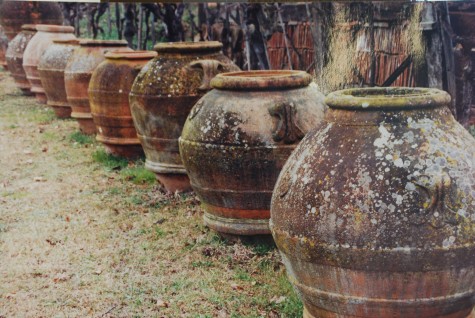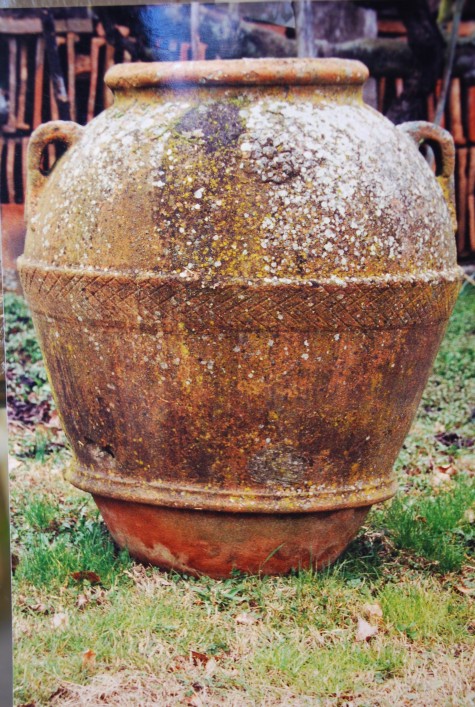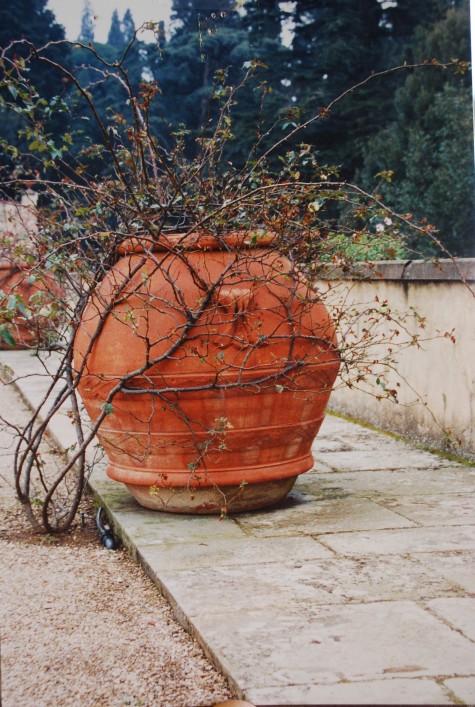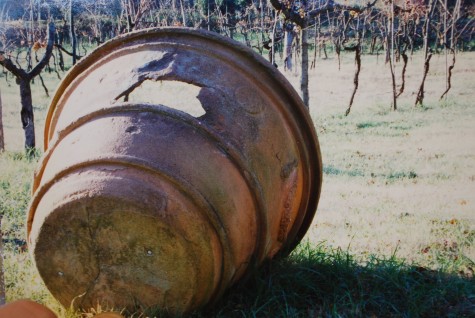
Apparently I am still writing about Italian terra cotta-bear with me if you can. The container that arrived just a few days ago has brought back a flood of memories from the past fifteen years shopping for great terra cotta-I have some 35mm images that describe those memories. Once the shop had a home, and an address, Rob went shopping not one bit more seriously, but in greater volume, and with more confidence. In the early 1990’s, he met and did business with Klaus and Ilona-they brokered Italian terra cotta from a number of different potteries. Rob would meet them in Florence, and shop. Though Klaus was German, his mother lived in Tuscany-in those days. Rob became part of their Italian/German family. Many bottles of great chianti and home bottled olive oil from Klaus’s Mom arrived in the container with our terra cotta in those days. They helped bring order to Rob’s orders. Few of the potteries we bought from did much business exporting to the US. The order we placed very early on with Carlo Chiti-the money disappeared, and our request for pots went unanswered. Carlo Chiti-if you are out there, we are still waiting for our pots. Klaus and Ilona no longer rep Italian terra cotta, but their generous help and support more than a decade ago taught Rob much about how to shop in Italy.
 The terra cotta pots, and sculptures manufactured by Mital are legendary. Giant and ornately sculpted vases from Mital grace gorgeous gardens all over the planet. In my opinion, the most beautiful classical Italian terra cotta pots ever made come from Mital. My own terra cotta collection revolves around pots from them.
The terra cotta pots, and sculptures manufactured by Mital are legendary. Giant and ornately sculpted vases from Mital grace gorgeous gardens all over the planet. In my opinion, the most beautiful classical Italian terra cotta pots ever made come from Mital. My own terra cotta collection revolves around pots from them.
A series of terra cotta pots of this exact design were made by Franco’s grandfather early in the 20th century for the Biltmore Estate. These replacements for two broken pots, made from the original mold, were about to be shipped when Rob visited Mital in 1998. Based on this photograph, I ordered three of them for the shop. One client spoke for all three-he is as crazy about classical Italian terra cotta as I am.
 Rob’s first trip to Mital in 1998-not so much about the history. It was much more about meeting people. Franco’s father’s vintage Lancia was as much a part of the landscape as the terra cotta. There was much discussion of that car. The personal relationships that Rob nurtured so many years ago over a love for fine terra cotta was instrumental in our ability to offer fine terra cotta to our gardening clients.
Rob’s first trip to Mital in 1998-not so much about the history. It was much more about meeting people. Franco’s father’s vintage Lancia was as much a part of the landscape as the terra cotta. There was much discussion of that car. The personal relationships that Rob nurtured so many years ago over a love for fine terra cotta was instrumental in our ability to offer fine terra cotta to our gardening clients.
 I cannot speak or write with any authority about the use of terra cotta pots for storage of olive oil. But I do know the terra cotta of the 12th and 13th century primarily consisted of jugs to hold water (mezzine), tiles and bricks for buildings, and jars for storing certain liquids and grains (orci). By the 16th century, as the production of olive oil became an increasingly more important agricultural product in Tuscany, the production of orci-those jars used for the storage of the oil- increased accordingly-dramatically.
I cannot speak or write with any authority about the use of terra cotta pots for storage of olive oil. But I do know the terra cotta of the 12th and 13th century primarily consisted of jugs to hold water (mezzine), tiles and bricks for buildings, and jars for storing certain liquids and grains (orci). By the 16th century, as the production of olive oil became an increasingly more important agricultural product in Tuscany, the production of orci-those jars used for the storage of the oil- increased accordingly-dramatically.
 In the yard at Mital, an incredible collection of antique terra cotta olive jars, side by side the olive jars still in production there. What was once traditionally made in Italy to store oil is still being made, though their use has expanded.
In the yard at Mital, an incredible collection of antique terra cotta olive jars, side by side the olive jars still in production there. What was once traditionally made in Italy to store oil is still being made, though their use has expanded.
 The ancient olive jars at Mital-a collection amassed over a lifetime by his father. Franco was clear-none of the ancient jars were for sale. Though they were simply diplayed at the pottery, they were a treasured reminder of all the the history of his craft. Glazed on the inside, olive jars both new and antique have a distinctive shape. The large oval bodies tapering at the bottom permitted the jars to be stored upright in metal or clay rings, or in wood braces aboard ships. The relatively narrow necks still permitted easy access to the oil; the handles were useful should the jar need to be moved.
The ancient olive jars at Mital-a collection amassed over a lifetime by his father. Franco was clear-none of the ancient jars were for sale. Though they were simply diplayed at the pottery, they were a treasured reminder of all the the history of his craft. Glazed on the inside, olive jars both new and antique have a distinctive shape. The large oval bodies tapering at the bottom permitted the jars to be stored upright in metal or clay rings, or in wood braces aboard ships. The relatively narrow necks still permitted easy access to the oil; the handles were useful should the jar need to be moved.
 Olive oil should be stored in a dark cool place for maximum longevity. The jars-perfect for this. But ancient terra cotta olive jars are incredibly beautiful in their own right. My personal collection of terra cotta from Italy includes one 18th century olive jar, purchased from an Italian antiques dealer in northern Italy. The year it arrived from Italy, Rob filled it with water. Unbelievably, the scent of olive oil filled the air.
Olive oil should be stored in a dark cool place for maximum longevity. The jars-perfect for this. But ancient terra cotta olive jars are incredibly beautiful in their own right. My personal collection of terra cotta from Italy includes one 18th century olive jar, purchased from an Italian antiques dealer in northern Italy. The year it arrived from Italy, Rob filled it with water. Unbelievably, the scent of olive oil filled the air.
Though I plant my jar with flowers every year, it is every bit beautiful enough to stand on its own, unplanted. The day it is moved to the deck for the summer is a very good day indeed. I spend plenty of time thinking through what I will plant-this part is my pleasure.
 This Italian olive jar, empty, but faithfully supporting a climbing rose-this might be my most favorite garden photograph ever. I have no idea where Rob took this picture, but it describes what I love so much about Italian gardens-they have a long standing romance with their gardens that is unmistakeable.
This Italian olive jar, empty, but faithfully supporting a climbing rose-this might be my most favorite garden photograph ever. I have no idea where Rob took this picture, but it describes what I love so much about Italian gardens-they have a long standing romance with their gardens that is unmistakeable.

This ancient terra cotta pot with obvious damage is an important visual part of this vineyard landscape. I am sure it was not placed here for that purpose. There simply was no thought to discard it. If I had the chance, would I buy a pot such as this? No doubt-yes I would.


Debra – I’m absolutely loving this series of posts. Those Italian terra cotta pots just take my breath away. I’m so excited for you! The day they deliver the pots, you must have felt like a kid on Christmas Day!
Dear Sheila, I am so enjoying writing this series-it’s like living those moments all over again. It has been a good while since we brought a container of Italian terra cotta over-I know now it’s been too long. I am very excited about it. Deborah
Deborah –
Wow; your “most favorite garden photograph ever.” You have seen many, many photos; that says a lot. That photo reminded me of The Giving Tree offering his stump to the old man (boy). While not the original purpose of the tree, that seat was valued indeed. Similarly, although not performing its intended use, the olive jar sturdily lends a shoulder to the rose. Notable also is how the two stand alone, yet in unison.
Eric
Well said, Eric. Thanks for writing, Deborah